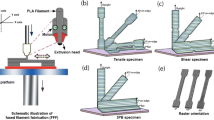Abstract
A prediction model of thermal contact conductance is developed. Engineering rough surfaces are characterized by three-dimensional fractal Weierstrass-Mandelbrot fractal function. Three deformation modes, including fully plastic deformation, elasto-plastic deformation and elastic deformation, are considered to analyze the contact mechanism. Fractal surface and three deformation modes are incorporated into the calculation of thermal contact conductance. A comprehensive thermal contact conductance computation model considering both base thermal resistance and constricted thermal resistance is established. The results show that thermal contact conductance increases with the increase of normal contact pressure; the relative contribution of constricted resistance component to base resistance component tends to increase with the increase of normal contact pressure; fractal dimension and fractal roughness both have significant influences on thermal contact conductance.
Similar content being viewed by others
References
J. A. Greenwood and J. B. P. Williamson, Contact of nominally flat surfaces, Proceedings of the Royal Society of London, 295 (1442) (1966) 300–319.
R. S. Sayles and T. R. Thomas, Surface topography as a nonstationary random process, Nature, 271 (5644) (1978) 431–434.
A. Majumdar and B. Bhushan, Fractal model of elasticplastic contact between rough surfaces, ASME J. Tribol, 113 (1) (1991) 1–11.
W. Yan and K. Komvopoulos, Contact analysis of elasticplastic fractal surfaces, Journal of applied physics, 84 (7) (1998) 3617–3624.
A. Zhou, T. Chen, X. Wang and Y. Xi, Fractal contact spot and its application in the contact model of isotropic surfaces, Journal of Applied Physics, 370 (4) (2015) 3617.
P. Liu, H. Zhao, K. Huang and Q. Chen, Research on normal contact stiffness of rough surface considering friction based on fractal theory, Applied Surface Science, 349 (2015) 43–48.
D. A. H. Hanaor, Y. Gan and I. Einav, Static friction at fractal interfaces, Tribology International, 93 (2016) 229–238.
W. Su, H. Liu, Y. Zhang and L. Wu, Rarefaction cloaking: Influence of the fractal rough surface in gas slider bearings, Physics of Fluids, 29 (10) (2017) 102003.
S. Wang and K. Komvopoulos, A fractal theory of the interfacial temperature distribution in the slow sliding regime: Part I—elastic contact and heat transfer analysis, Journal of Tribology, 116 (4) (1994) 812–822.
L. Kogut and I. Etsion, Elastic-plastic contact analysis of a sphere and a rigid flat, Journal of Applied Mechanics, 69 (5) (2002) 657–662.
Y. Zhao, Y. Lu and J. Jiang, New elastic-plastic model for the contact of rough surfaces, Jixie Gongcheng Xuebao (Chinese Journal of Mechanical Engineering), 43 (3) (2007) 95–101.
Y. R. Jeng and P. Y. Wang, An elliptical microcontact model considering elastic, elastoplastic, and plastic deformation, Encyclopedia of Lubricants & Lubrication, 125 (2) (2003) 292–292.
G. Pugliese, S. M. O. Tavares, E. Ciulli and L. A. Ferreira, Rough contacts between actual engineering surfaces: Part ii. contact mechanics, Wear, 264 (11–12) (2008) 1116–1128.
J. L. Liou and J. F. Lin, A modified fractal microcontact model developed for asperity heights with variable morphology parameters, Wear, 268 (1–2) (2010) 133–144.
X. Miao and X. Huang, A complete contact model of a fractal rough surface, Wear, 309 (1–2) (2014) 146–151.
X. Li, B. Yue, D. Wang, Y. Liang and D. Sun, Dynamic characteristics of cylinders’ joint surfaces considering friction and elastic-plastic deformation based on fractal theory, Australian Journal of Mechanical Engineering, 15 (1) (2017) 11–18.
M. G. Cooper, B. B. Mikic and M. M. Yovanovich, Thermal contact conductance, International Journal of Heat and Mass Transfer, 12 (3) (1969) 279–300.
B. B. Mikić, Thermal contact conductance; theoretical considerations, International Journal of Heat and Mass Transfer, 17 (2) (1974) 205–214.
P. Sadowski and S. Stupkiewicz, A model of thermal contact conductance at high real contact area fractions, Wear, 268 (1–2) (2010) 77–85.
C. Ji, H. Zhu and W. Jiang, Fractal prediction model of thermal contact conductance of rough surfaces, Chinese Journal of Mechanical Engineering, 26 (1) (2013) 128–136.
C. Ma, L. Zhao, H. Shi, X. Mei and J. Yang, A geometrical-mechanical-thermal predictive model for thermal contact conductance in vacuum environment, Proceedings of the Institution of Mechanical Engineers, Part B: Journal of Engineering Manufacture, 230 (8) (2016) 1451–1464.
C. Ma, L. Zhao, H. Shi, X. Mei and J. Yang, Experimental and simulation study on the thermal characteristics of the high-speed spindle system, Proceedings of the Institution of Mechanical Engineers, Part C: Journal of Mechanical Engineering Science, 231 (6) (2017) 1072–1093.
Y. Zhao, C. Fang, L. Cai and Z. Liu, A three-dimensional fractal theory based on thermal contact conductance model of rough surfaces, Proceedings of the Institution of Mechanical Engineers, Part E: Journal of Process Mechanical Engineering (2017) 0954408917727198.
M. Zou, B. Yu, J. Cai and P. Xu, Fractal model for thermal contact conductance, Journal of Heat Transfer, 130 (10) (2008) 101301.
A. Tariq and M. Asif, Experimental investigation of thermal contact conductance for nominally flat metallic contact, Heat & Mass Transfer, 52 (2) (2016) 291–307.
R. Xu, H. Feng, L. Zhao and L. Xu, Experimental investigation of thermal contact conductance at low temperature based on fractal description, International Communications in Heat & Mass Transfer, 33 (7) (2006) 811–818.
S. Wang and K. Komvopoulos, A fractal theory of the interfacial temperature distribution in the slow sliding regime: Part ii—multiple domains, elastoplastic contacts and applications, Journal of Tribology, 116 (4) (1994) 824–832.
Author information
Authors and Affiliations
Corresponding author
Additional information
Recommended by Associate Editor Bong Jae Lee
Ke Yan received his Ph.D. in the School of Mechanical Engineering from Shandong University, China, in 2012. Currently, he is an Associate Professor and master tutor in the School of Mechanical Engineering, Xi’an Jiaotong University, China.
Rights and permissions
About this article
Cite this article
Zhang, J., Liu, Y., Yan, K. et al. A fractal model for predicting thermal contact conductance considering elasto-plastic deformation and base thermal resistances. J Mech Sci Technol 33, 475–484 (2019). https://doi.org/10.1007/s12206-018-1247-9
Received:
Revised:
Accepted:
Published:
Issue Date:
DOI: https://doi.org/10.1007/s12206-018-1247-9




